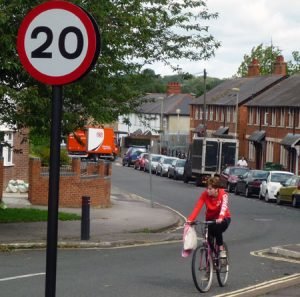20 mph: popular and life-saving
By Alison Hill
Alison is Chair of Cyclox
Following the narrow Conservative victory in the Uxbridge by-election, attributed to the public’s concern about ULEZ, Prime Minister Rishi Sunak has said he is considering banning councils from imposing 20 mph. This would be a way of demonstrating that he is on the side of motorists.
Wales is the first country in the UK to legislate for 20 mph as the national speed limit in built-up areas. The ruling comes into force on 17 September 2023. The charity 20s Plenty For Us says that 20 million people in England live in local authorities that are rolling out 20 mph in residential streets. The fact that no council has ever gone back to a 30 mph limit in a 20 mph street says a lot about how positively the reduction in speed is received by residents. Trustworthy surveys of residents show there is strong support for 20 mph in their streets. And 20 mph limits work. Even without traffic-calming measures research shows that average speeds reduce when 30 mph streets become 20 mph.
What is happening locally?
In Oxfordshire, creating 20 mph streets in built-up areas is a key policy in the Local Transport and Connectivity Plan and the Vision Zero strategy (which is about eliminating deaths and serious injury on the roads).
The 20 mph limit has proved popular with local communities in the county.

Parishes or town councils have to apply to join the scheme, having consulted their communities. Take a quick look at Oxfordshire County Council’s consultation portal and you will see that every month there are further proposals for 20 mph zones in towns and villages. The roll out of the scheme is taking place over 3 years, and already 79 villages and towns have 20 mph schemes, 20 are about to be implemented, and 60 are awaiting approval by the Cabinet Member for Highways in the autumn. That’s an impressive 159 villages and towns.
In Oxford city residential streets have been 20 mph since 2010, following strong campaigning by local groups. But main roads in Oxford are still 30 mph. Most collisions take place at busy junctions on main roads – think of the last four tragic fatalities in Oxford, on Horspath Driftway, on London Road Headington, at Oxford Parkway Station, and on the Plain. Reducing speeds to 20 mph can be life-saving. And why should residents on main roads not enjoy the benefits too?
The benefits of 20 mph
There is clearly high demand for 20 mph and for good reasons. Streets feel safer when vehicles are travelling at 20 rather than 30 mph and the risk of fatality or serious injury is much reduced. People are more likely to walk or cycle on streets where traffic is moving more slowly. For the motorist another benefit is that fuel consumption is reduced at slower speeds.
Implementing 20 mph is within the power of local highways authorities, such as Oxfordshire County Council, granted by the 1984 Road Traffic Regulation Act. If the government chooses to take action to ban 20 mph it will require legislative change. There are so many other pressing issues facing our country. It seems unwise to give legislative time to reversing a policy that is good for neighbourhoods, good for health, makes our roads safer, and is popular. Instead, 20 mph should be the default speed limit for streets in built-up areas where people shop, live and work, as it will be in Wales from September.
Is that extra minute saved in journey time worth the increased risk of injury and death to other road users? We already have too many deaths on our roads in Oxford and Oxfordshire. We need more 20 mph speed limits not fewer.
